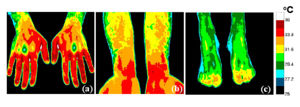Complex regional pain syndrome
In pain medicine, complex regional pain syndrome encompasses a range of chronic pain conditions with "continuous, intense pain out of proportion to the severity of the injury, which gets worse rather than better over time."[1] It is often the result of an injury, to soft tissue or nerves, that has produced abnormalities in nerves, not only those normally associated with direct pain transmission but also in the sympathetic branch of the autonomic nervous system. Autonomic signs and symptoms include "reddening of the skin (erythema); skin temperature changes, abnormal sudomotor activity (i.e., changes in sweating due to altered sympathetic innervation) or edema." [2]
The pain is often disproportionate to what would be associated with the original injury. Cases where there is an identifiable injury are called causalgia or Type II complex regional pain syndrome. In other cases, the autonomic signs are present, but there is no clear associated injury; these are Type I disease or reflex sympathetic dystrophy.
History
In 1851, neurologist Claude Bernard was the first to describe an association association between In 1851, Claude Bernard (1813-1878) was the first to identify a pain syndrome that was linked to sympathetic dysfunction. "A student of Bernard’s, Silas Weir-Mitchell (1829-1914), employedthe term “causalgia” to describe the pain he diagnosed in American Civil War veterans (Greek: kausos=heat, algos=pain)."[3] J. Evans first coined the term “reflex sympathetic dystrophy” (RSD), in a 1946 article.[4]
Diagnosis
Imaging
Thermography is being evaluated, " asymmetric thermal pattern between pain and contralateral pain free sites; (b) comparisons of blood flow measured by laser Doppler imaging (LDI) between the two sides; and (c) sympathetic response of blood flow and temperature patterns in the two sides following cold stimulation...symmetric thermal patterns and sympathetic responses on the two sides after applying cold stimulations are observed. On the other hand, no remarkable difference is observed between the two sides in LDI blood velocity images. The thermal pattern on the most painful side before drug or placebo treatment is typically warmer by at least 1oC spread over a large area. After treatment, thermography shows cooler temperatures on the painful side than the contralateral side." [5]
Treatment
In addition to opioid analgesics and other drugs used in chronic pain, such as antidepressants and anticonvulsants, regional sympathetic nerve blocks may be helpful.
References
- ↑ NINDS Complex Regional Pain Syndrome Information Page, National Institute of Neurological Disorders and Stroke, National Institutes of Health
- ↑ Anonymous (2024), Complex regional pain syndrome (English). Medical Subject Headings. U.S. National Library of Medicine. From Pain 1995 Oct;63(1):127-33)
- ↑ R. Norman Harden and Stephen Bruehl (June 2006), Introduction and Diagnostic Considerations, in R. Norman Harden, Complex Regional Pain Syndrome: Treatment Guidelines, Reflex Sympathetic Dystrophy Syndrome Association
- ↑ Evans J. "Reflex sympathetic dystrophy". Surg Clin N Amer, 1946;26:780, quoted in Harden & Bruehl}}
- ↑ Imaging Reflex Synpathetic Dystropy, National Institutes of Health

